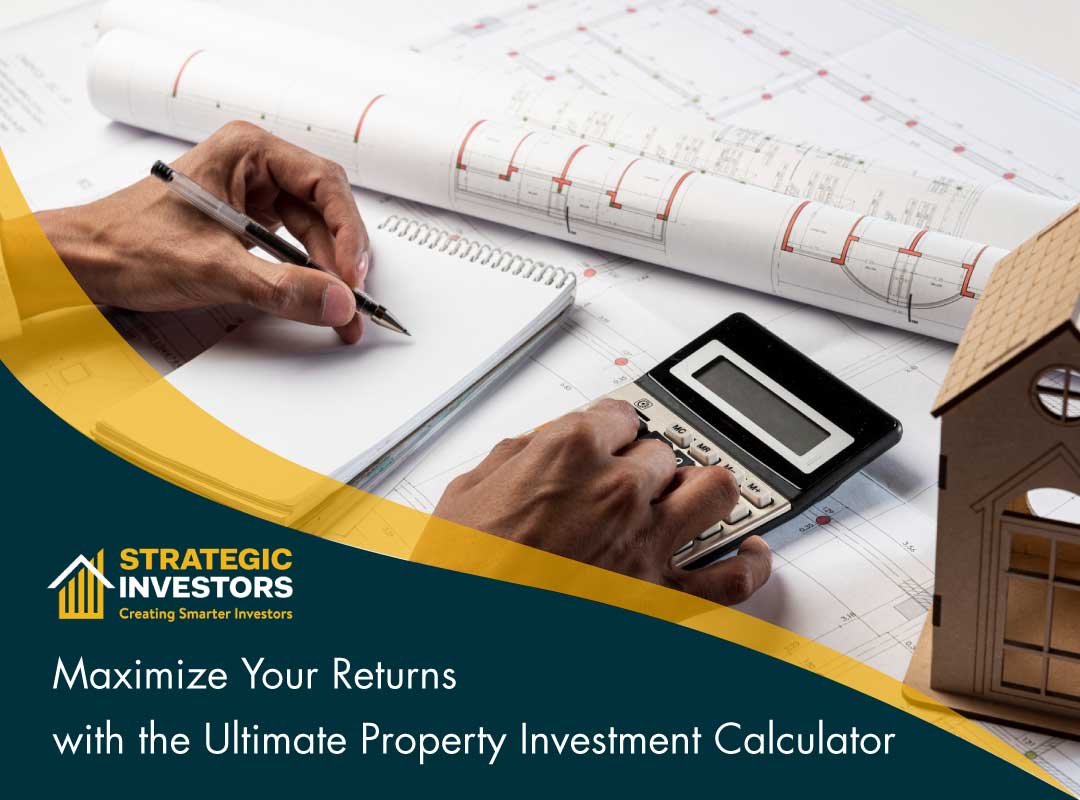
Investing in property can be a daunting task, but luckily there are now investment calculators to help reduce the risk and make informed decisions.
In this blog post, we’ll go through different types of calculator options for analyzing your potential investments with regards to key metrics.
So you can maximize returns when investing in real estate here in Australia.
Key Takeaways
- Property investment calculators in Australia provide a convenient and accurate way to calculate potential return on residential investments.
- Consider key metrics such as rental yield, capital growth, cash flow and capitalization rate when making decisions.
- Analyze results of an investment property calculator to evaluate performance & identify tax benefits. Be aware of market conditions, interest rates & loan terms for maximum returns.
Understanding Property Investment Calculators for Australia
 Figuring out the realm of property investment is quite intimidating, especially regarding its financial implications. To assist in this process and make smart choices that mitigate risk, calculators developed for residential properties in Australia can give an idea of the returns associated with any investment property, including considerations about body corporate charges.
Figuring out the realm of property investment is quite intimidating, especially regarding its financial implications. To assist in this process and make smart choices that mitigate risk, calculators developed for residential properties in Australia can give an idea of the returns associated with any investment property, including considerations about body corporate charges.
Types of Calculators
Property investors can select from various calculators to best cater their needs. Some popular ones include Cash Flow Calculator, Negative Gearing Calculator and Affordability Calculator.
The purpose of the first calculator is to compute an investment’s cash flow return on investment (CFROI) for a rental property while the second one evaluates tax benefits when investing in negatively geared residential properties. The third allows calculating what loan amount could be obtained for buying a particular property as well as understanding how much should you pay off monthly through your loan repayment plan without taking risks with affordability issues.
Each type of calculator focuses on different aspects that are essential to realizing successful investments goals. Hence it’s important they’re chosen accordingly by real estate entrepreneurs who want adequate profits out of them ventures.
Key Metrics to Consider
When utilizing a property investment calculator, it’s crucial to understand the metrics that can impact your decisions. Such critical factors include rental yield, capital growth and cash flow.
The capitalization rate helps assess potential returns from an asset or real estate venture – determined by dividing the net operating income (NOI) against either its current market value or initial purchase price of said investment. Considering these figures provides users with insight on how lucrative any given property may be for them in terms of both money and income generation capacity.
How to Use a Property Investment Calculator
 Using a property investment calculator in Australia involves providing detailed information like the property’s value, net operating income, expenses and potential returns. This section serves to guide users through how to input this data correctly so they can get reliable results.
Using a property investment calculator in Australia involves providing detailed information like the property’s value, net operating income, expenses and potential returns. This section serves to guide users through how to input this data correctly so they can get reliable results.
The first step is accounting for the total worth of the asset by factoring in any cash flow or capital growth that will come from investing into it. Next factor all operational costs related to owning and maintaining that particular real estate such as repairs, taxes and insurance premiums, etc. Finally, account for your expected return on investments such as rental fees or other sources of revenue generated from having ownership over said asset.
We have many calculators available for you to use in property investing. Visit are calculator page to work out your costs in property investing.
Inputting Property Details
For an exact assessment of the cash flow generated by your investment property, you must input its purchase cost, rental income and related expenses. The price tag is essential for calculating prospective returns on this particular real estate asset. Don’t forget to take into account all relevant costs so that you have a realistic picture of what kind of profits or losses may be expected from the venture.
Analyzing Results
The calculator can provide estimates on the financial details of an investment property, such as its rental income, operating expenses, and cash flow. It also reveals a return-on-investment (ROI). To determine rental yield percentage, use this formula: divide annual rent by purchase cost then multiply it by 100. Analyzing these results helps you make decisions about which property to invest in more easily compared to other properties available in the market. Benefits include possible tax savings from negative gearing or potential refunds due to rental earnings against paid taxes for that specific housing asset/property.
Factors Affecting Your Property Investment
 Understanding the components that can affect a property investment is key to maximizing returns. Factors such as market trends, loan agreement stipulations and interest rates should all be taken into consideration when using an investment calculator. It’s important not to forget about potential fees associated with managing said property investments, something which must always factor in if you hope for your plans to reach fruition. Accounting for these items helps ensure investors make well-informed decisions on their next move within this space.
Understanding the components that can affect a property investment is key to maximizing returns. Factors such as market trends, loan agreement stipulations and interest rates should all be taken into consideration when using an investment calculator. It’s important not to forget about potential fees associated with managing said property investments, something which must always factor in if you hope for your plans to reach fruition. Accounting for these items helps ensure investors make well-informed decisions on their next move within this space.
Market Conditions
Property cycles and demand are key components of ensuring a successful property investment. Knowing what stage the market is currently in can be extremely helpful when making decisions about buying or selling an asset at the right price. Property cycles typically include four distinct phases: growth, decline, stabilization and expansion.
Additional considerations such as accessibility to local facilities/services, changes in population size near your desired location and access to job markets could all heavily influence returns from any investments made there.
Staying abreast of information concerning current conditions within the realm of real estate investing may result in substantial financial gains if accurately identified before jumping into any large scale transactions involving property assets you intend on purchasing for investment purposes.
Interest Rates and Loan Terms
When looking into property investment, it is important to take interest rates and loan terms into consideration for the greatest return on your investments. Lower interest rates mean that loans are easier to obtain, thereby creating an increase in demand of properties as well as a potential rise in their values. On the other hand, higher interests equate with tougher borrowing requirements causing more expensive financing costs and potentially reduced appeal towards investing in property. Having accurate knowledge about these factors will help you make sound decisions when undertaking any kind of property related venture while simultaneously managing risks associated with it.
Property Management Fees and Other Costs
When analyzing potential returns from property investment, it is important to take into account the associated costs. These typically include not only property management fees (which usually range between 5% and 15%, with an average of 7.5%), but also other expenses such as maintenance costs, vacancy periods’ charges, advertising/marketing charges, insurance premiums or legal fees for leases or contracts related to rental properties. Property taxes should likewise be considered when assessing a particular return on one’s investments in real estate.
Accounting all these various factors will help investors obtain a more precise understanding of their prospective profits generated by property ownership. It may even be beneficial for them to look at reducing strata fees and additional costs wherever possible so that they can maximize the value they get out of their purchase!
Tax Considerations for Property Investors
 As a property investor in Australia, it’s important to be mindful of any applicable taxes that may influence your investment profits. This section covers income tax pertaining to rental earnings as well as stamp duty and other types of taxation pertinent for those investing in the realm of real estate.
As a property investor in Australia, it’s important to be mindful of any applicable taxes that may influence your investment profits. This section covers income tax pertaining to rental earnings as well as stamp duty and other types of taxation pertinent for those investing in the realm of real estate.
Income Tax on Rental Income
The Australian tax system imposes income taxes on rental profits. These usually relate to a person’s marginal rate for the financial year. You can take into account certain deductions such as interest payments made towards home loans and property management fees, plus expenditure associated with repairs and maintenance costs, insurance premiums, as well as being liable for council rates or land taxes. To ensure an understanding of how taxation will affect your investment property returns, it is wise to be aware of these factors in order to determine profitability.
Stamp Duty and Other Taxes
Property investors in Australia are required to pay income tax, as well as other taxes related to their properties. Stamp duty is one such charge that should be taken into account. These rates can vary between 1-5.5% of the property’s value and it’s advised for individuals to double check with a tax expert or relevant government websites on current thresholds/rates applicable for stamp duty calculations before investing in any particular state or territory within Australia. They must also take land and capital gains taxation measures into consideration when looking at purchasing real estate investments here too, both which rely upon the associated values of their properties relating to revenue generated from those same assets by way of rental incomes etc.
Tax Deductions and Benefits
Property owners who invest in property can benefit from various tax incentives, such as negative gearing and depreciation allowances. Through this process of leveraging deductions and benefits for their investment income, these individuals may find that it helps to reduce the overall amount they owe in taxes while increasing returns on their real estate investments. With negative gearing, a property investor is permitted to claim losses incurred by them against other forms of income when filing taxation documents each year. There are also provisions available where investors would be able to claim decreases due to changes in value over time, which then leads directly into lowering taxable revenue earned from the financial gain made with said assets or properties invested within.
Tips for Choosing the Right Investment Property in Australia
 Once you’re aware of the various factors influencing property investment and taxes involved, it’s essential to settle on an ideal rental asset in Australia. Here we’ll provide tips for selecting a location that is right for your needs, what type of properties should be taken into consideration as well as how to evaluate its potential yield so that you can make sound investments.
Once you’re aware of the various factors influencing property investment and taxes involved, it’s essential to settle on an ideal rental asset in Australia. Here we’ll provide tips for selecting a location that is right for your needs, what type of properties should be taken into consideration as well as how to evaluate its potential yield so that you can make sound investments.
Location Factors
When selecting a property for investment, location is paramount in order to get the most out of it. It’s essential to consider accessibility to amenities, population growth rate and job opportunities. Take into account the lifestyle offered by that area when making your decision. This will help you boost returns while minimizing risk associated with investing in real estate. Taking advantage of locations with high potential growth as well as strong demand is what can give you significant value from your investment property and yield long-term financial rewards.
Property Types and Features
When looking for a suitable investment property, it is important to consider the type and features that could have an effect on returns. Houses are by far the most popular choice in Australia due to their excellent rental income potential as well as capital growth opportunities. Elements such as size, age or building quality can significantly affect its worthiness of being chosen over others when making your decision.
By selecting real estate with desirable characteristics which offer high ROI possibilities, one’s chances of achieving successful investments results from this venture.
Evaluating Rental Yield
Investors can calculate the potential cash flow from an investment property by measuring its gross rental yield. To determine this, take the annual rental income divided by the purchase cost of a property and multiply it to get a percentage figure. Using a rent yield calculator may help with this process. Analyzing these numbers enables you to evaluate how your particular asset is performing to others on the market.
Case Study: Maximizing Returns with a Property Investment Calculator
Using a property investment calculator, we can easily get an idea of the cost and potential returns from an hypothetical real estate purchase. To start this analysis, details such as loan percentage, rental income earned and expenses must be inputted into the system.
With all these factors in place it is then possible to adjust variables like purchase price or expected revenue for improved projections on profitability with greater accuracy when making decisions about whether to invest in that particular piece of property or search elsewhere for better options.
Through using a tool designed specifically to calculate investments related to properties one may have insight into capital growth possibilities while observing the profit yield based on given figures around how much money will come back through rentals received after any applicable loans are taken out against said residential asset acquisition.
Summary
In sum, a property investment calculator can be invaluable in analyzing Australian real estate investments. It enables you to better consider significant elements such as possible returns, taxes and other factors that determine the success of an endeavor like this, providing you with helpful intelligence to make smart decisions and maximize profit potentials when investing in properties down under. Utilizing these types of tools is essential for achieving your financial goals effectively within the property market here.
Frequently Asked Questions

How do you calculate cash flow on an investment property?
Using a calculator, you can quickly calculate the cash flow potential of an investment property. Input all relevant variables to get your desired results for this type of investment and its related income stream.
What is the 1% rule in property investing?
Property investing requires rental income to make up for at least 1% of the purchase price, so that a positive cash flow can be achieved. This is referred to as the 1% rule. To ensure profitability from such investments, mortgages should also be taken out with payments less than this percentage amount derived from rental income and sale price alike. By executing proper investment strategies related to these two main components (rental/income & purchasing power), investors may hope to secure satisfactory returns on their capital gains via property purchases in regards both short-term and long-term outlooks of profit seeking endeavors within real estate markets.
How do I know if my investment property is profitable?
When considering whether an investment property can be successful, the net operating income should be taken into account in relation to its worth. To calculate the return on investment (ROI), divide your yearly earnings by all costs incurred during investing.
If you adhere to a one-percent rule and have achieved at least 7% from the initial value of your property, then it is likely that your venture will turn out profitable.
What is the 2% rule for property investment?
The 2% rule states that a property should produce monthly rents of at least 2% of the purchase price in order to be considered a “good investment”.
How to calculate if a property is a good investment Australia?
When considering if a property in Australia is a wise investment, one should work out whether the rent pays 2% or more of what was spent to buy it. For instance, for every $500,000 purchase price, there must be at least $10,000 collected in monthly rent income.













